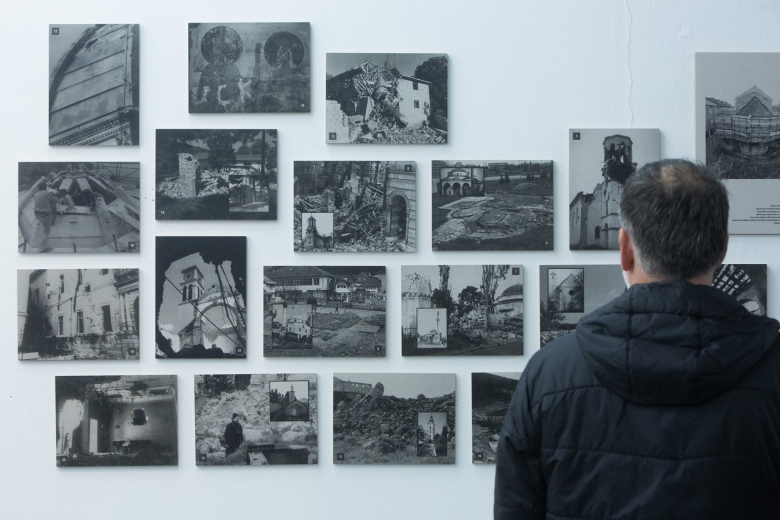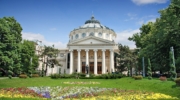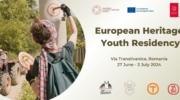“Targeting History and Memory” 3-year project completed successfully with many events across Europe
With no less than 13 activities carried out throughout 2016, 2017 and 2018 and involving 870 citizens from across Europe and beyond, the project “Targeting History and Memory”, supported by European Union under the Programme “Europe for Citizens” (Strand 1 – European Remembrance), has been successfully completed. Europa Nostra was a supporting partner of this European project, which was developed and implemented by SENSE – Centre for Transitional Justice (Pula, Croatia) and Documenta – Centre for Dealing with the Past (Zagreb, Croatia) together with the Humanitarian Law Centre (Belgrade, Serbia) and the Historical Museum of Bosnia and Herzegovina (Sarajevo). The project is based on the interactive narrative “Targeting History and Memory“, produced by Sense – Centre for Transitional Justice, and the related exhibition “Targeting Monuments – Targeting History and Memory” which raises awareness of the deliberate destruction of cultural heritage during the 1991-1999 wars in the former Yugoslavia. The exhibition was curated by Branka Benčić, while the texts for the exhibition and the catalogue were written by Mirko Klarin, from Sense Agency, Helen Walasek, University of Exeter, Andras Riedlmayer, Harvard Library, and Višnja Kisić, Europa Nostra.
After presenting the interactive narrative throughout 2016, the exhibition travelled through several cities of the former Yugoslavia in 2017: from Croatia (Glyptotheque of the Croatian Academy of Sciences and Arts in Zagreb and SENSE – Centre for Transitional Justice in Pula), Serbia (Centre for Cultural Decontamination in Belgrade), to Bosnia and Herzegovina (Historical Museum of Bosnia and Herzegovina in Sarajevo). Europa Nostra was associated with the final display of the exhibition which took place in The Hague, Netherlands (City Hall) from 4-16 April 2018. Judge Carmel Agius, last President of the International Criminal Tribunal for the former Yugoslavia (ICTY) opened the exhibitions in Sarajevo and The Hague while Serge Brammertz, the Chief Prosecutor of the ICTY and the UN Mechanism for International Criminal Tribunals, opened the exhibition in Pula, in which war crime prosecutors from Croatia, Serbia, and Bosnia and Herzegovina also participated.
Other important events included an international conference in Pula (Croatia), a study trip (Sarajevo – Mostar – Dubrovnik), as well as a regional seminar for high-school history teachers from Croatia, Bosnia and Herzegovina, and Serbia.

Targeting Monuments, exhibition in Glipoteka, Zagreb / Photo: HINA
You will find below an overview of all the events which took place in the framework of the project “Targeting History and Memory” in chronological order and with accompanying links.
November 2016: Narrative on the destruction of Cultural Heritage presented in Zagreb and Sarajevo:
The interactive narrative “Targeting History and Memory” was presented in the Historical Museum of Bosnia and Herzegovina in Sarajevo and the Mimara Museum in Zagreb, Croatia.
December 2016: Targeting History and Memory in Belgrade and Podgorica:
The interactive narrative “Targeting History and Memory” premiered in Belgrade, Serbia, at the Parobrod Cultural Institution, in association with the Humanitarian Law Center, and in Podgorica, Montenegro, at the Civic Education Center.
19 December 2016: Narrative Targeting History and Memory presented in Kosovo:
The interactive narrative “Targeting History and Memory” was presented in Kosovo in two events, in Priština and in the Visoki Dečani monastery, in cooperation with the Kosovo Humanitarian Law Center. The presentation focused in particular on the parts of the narrative that pertain to Kosovo and the efforts to prosecute crimes against the cultural and religious heritage at the ICTY. The efforts to eradicate history and memory were discussed on 18 December 2016 in the Serbian Orthodox monastery in Visoki Dečani. Archimandrite Sava Janjić, the igumen of the Visoki Dečani monastery, received the representatives of the Kosovo Humanitarian Law Center and SENSE – Center for Transitional Justice.
April 2017: Targeting Monuments in Zagreb:
Zagreb was the first city to host the exhibition on the destruction of historical, cultural, and religious monuments in the wars in the former Yugoslavia. The Gliptoteka gallery, run by the Croatian Academy of Arts and Sciences (HAZU) hosted the opening of the exhibition curated by Branka Benčić, who was assisted by Tihana Puc, Barbara Blasin and Sandra Vitaljić. Before the opening, there was a panel discussion on the destruction of historical and cultural monuments, moderated by Eugen Jakovčič; art historians Snješka Knežević and Zvonko Maković, museologist Marko Sjekavica, and directors of Documenta and SENSE, Vesna Teršelič and Mirko Klarin.
May 2017: “Targeting Monuments” in Belgrade:
There was not an empty seat in the Center for Cultural Decontamination pavilion in Belgrade, the venue which hosted the exhibition entitled Targeting Monuments. The exhibition was presented to the audience by the authors. Prior to the official opening, a panel discussion on the culture of remembrance, the importance of the preservation of the historical, cultural and religious heritage and its protection was held. Among the panellists were culturologist Milena Dragićević Šešić, historian Olga Manojlović Pintar and one of the co-authors of the narrative, Mina Vidaković. The discussion was moderated by Jelena Krstić from FHP. More info: http://www.hlc-rdc.org
June 2017: Targeting Monuments exhibition opens in Sarajevo:
Judge Carmel Agius, the last president of the International Criminal Tribunal for the former Yugoslavia (ICTY), opened the exhibition Targeting Monuments – Targeting History and Memory at the Historical Museum of Bosnia and Herzegovina in Sarajevo. In his speech, he praised the joint initiative launched by civil society organisations from Croatia, Serbia, Bosnia and Herzegovina, and the Netherlands, as being ‘a demonstration of the kind of cooperation that the region of the former Yugoslavia needs on all levels’.
23-27 June 2017: Regional seminar for educators / Study trip Sarajevo – Mostar – Dubrovnik:
The educational cycle of the project “Targeting History and Memory” was carried out in cooperation with EUROCLIO (European Association of History Educators) and comprised three units:
- Professional and expert guidance at the exhibition “Targeting Monuments – Targeting History and Memory” in Sarajevo
- Regional seminar held at the Historical Museum of Bosnia and Herzegovina on the 24-25 June 2017 with 30 history teachers and educators from Croatia, Bosnia and Herzegovina, and Serbia
- Study trip that started on 25 June in Sarajevo and included a visit to the following sites and locations: SARAJEVO – The City Hall, Ferhadija Street, Markale Market, Eternal Flame, Srebrenica Genocide Memorial, Sarajevo Memorial to the Children Killed during the 1992-1995 Siege, and Vraca Memorial Park; MOSTAR – The Old Bridge, separation lines during the Croatian-Bosniak conflict, Boulevard and Šantić Street, and Partisan Memorial Cemetery; DUBROVNIK – The Old Town, War Photo Limited – Exhibition centre of war and conflict photojournalism (by Wade Goddard)
13 October 2017: SENSE Documentation Center & Targeting Monuments exhibition open in Pula:
The opening ceremony for the SENSE documentation centre for transitional justice was held in Pula in the presence of Serge Brammertz, the Chief Prosecutor of the ICTY and the war crimes prosecutors from Croatia, B-H and Serbia, representatives of the City of Pula and numerous guests from the region and the world. In his address, Serge Brammertz said that the centre is “a unique place where the events that took place in the former Yugoslavia in the 1990s are shown through the history of the trials before the ICTY, and SENSE’s audio-visual archive about the work of the Tribunal will “tell a story” about the events that shaped the history of the former Yugoslavia”. He added that “this Center will enable the creation of the forum for the education of the future generations on the legacy of the trials before the Tribunal“. On the same occasion, the exhibition Targeting Monuments opened at the Centre’s premises.
14 October 2017: International conference “Destroying Cultural Heritage, Post-War Reconstruction, and Trust Building” held at SENSE Documentation Centre in Pula:
In 3 panel discussions, the conference analysed what has been done in the last two decades and what has been learnt about the importance of cultural and religious heritage in war conflicts, and which challenges still remain regarding the reconstruction of cultural heritage, post-war peace-building, and the problems of divided societies in the region of South-East Europe. The key speakers at the conference included the ICTY Chief Prosecutor, war crime prosecutors from Croatia, Serbia, and Bosnia and Herzegovina, as well as activists and international experts on the protection of cultural heritage who witnessed to the scale of destruction of cultural heritage at many trials at the ICTY concerning the wars in the 90s in Croatia, Bosnia and Herzegovina, and Kosovo. Višnja Kisić, Secretary General of Europa Nostra Serbia, was among the key speakers of the first panel on “Understanding the Role of Cultural Heritage in Identity Building and Wars in the Former Yugoslavia”. She also moderated the third panel focusing on “The Role of Heritage in Post-War Reconstruction, Peace-Building and Cooperation: Lessons Learnt on Different Approaches”.
4 April 2018: Exhibition “Targeting Monuments“ opens in The Hague:
The exhibition ‘Targeting Monuments – Targeting History and Memory’ was launched on 4 April at the Atrium of the City Hall of The Hague. Judge Carmel Agius, the last President of the International Criminal Tribunal for the former Yugoslavia (ICTY) opened the exhibition and stated that it is ‘an excellent example of how the legacy of the ICTY must and will remain relevant and impactful well beyond the closure of the Tribunal”. As a project supporting partner, Europa Nostra was represented at the event by its Secretary General Sneška Quaedvlieg-Mihailović. Branka Benčić, Curator of the exhibition, and Mina Vidakovic, Deputy Director of SENSE – Centre for Transitional Justice, on behalf of its Director Mirko Klarin, and Geert Dijkstra, Senior International Advisor at The Hague Municipal Department of International Affairs, also addressed the audience.







